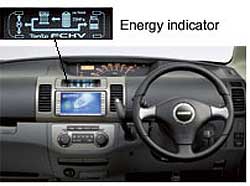Daihatsu Tanto FCHV
The Daihatsu Tanto FCHV (fuel cell hybrid vehicle) is also a mini MPV (multi purpose vehicle) and sits on the frame of the Daihatsu Tanto mini vehicle. Developmentally the Tanto FCHV is based on the Daihatsu Move FCV-K2. Similar in appearance to the Honda Element or the Scion xB, the Daihatsu Tanto FCHV seats up to four adults comfortably, despite the fact that it is a compact car.
 Daihatsu Tanto FCHV Mini MPV |
The Daihatsu Tanto FCHV uses a fuel cell stack (30 kw) developed by Toyota and has placed this stack underneath the seats for increased roominess. The front-wheel drive 32 kw electric motor and nickel-metal hydride battery pack provides the torque and an exceptionally quiet ride.
The Dahatsu Tanto FCHV made its first public appearance at the Tokyo Auto Show in October of 2005. Since then it has garnered a fair amount of attention primarily because they have increased the size of the hydrogen tank (35MPa), allowing greater distances between fill-ups (96 miles), while at the same time reducing the size of the battery and placing it in the rear compartment, giving the car much more passenger space.
Toyota has also added LED lights to this model in the Tanto, reducing the amount of energy it needs to run. Although it may seem like a small detail, headlights and interior lighting can place a considerable amount of strain on a battery. Leaving headlights on for just a few hours, for example, can leave a car unable to start without a jump. Reducing the power that goes to lighting makes the car much more efficient.

Like most cars at exhibits and auto shows, the Daihatsu Tanto FCHV will not be in production for consumers for at least several years, if ever. However, the car is important because it demonstrates how forward-thinking automobile companies are dealing with the problems that equipping cars with fuel cells brings, namely, the cost of the technology, passenger comfort, driving speed and maximizing the range of the vehicle. The Daihatsu Tanto FCHV is currently in a leasing agreement with Osaka Prefectural Government in Japan.
| Daihatsu has also added an energy indicator to this model. Much like the gas gauge on your car, this energy gage can accurately tell drivers how much power their vehicle has left, making it more user-friendly and easier to drive. |
The Daihatsu Tanto FCHV energy indicator lets fleet drivers know when its time to pull over to the nearest hydrogen fueling station or head back to base camp for their next fuel up. |
Although not a big advancement, most fuel cell prototypes still don’t have an accurate way for the driver to gauge how much further they could go before needing more hydrogen for the tanks.
All in all, the Dahatsu Tanto FCHV shows that future hydrogen car design doesn’t have to be based upon the engines and drive trains of older automobiles. More passenger room and comfort can be had with newer fuel cell based models and its simply a matter of allocating the components sensibly throughout the vehicle that will drive even future design improvements.
